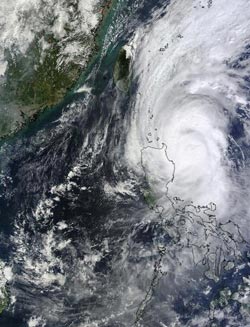NASA sees Halloween Typhoon Krosa lashing Luzon, Philippines

On Oct.31 at 0255 UTC, NASA's Terra satellite captured this picture of Tropical Storm Krosa's western edge over Luzon in the northern Philippines.<br><br>Credit: NASA Goddard MODIS Rapid Response Team<br>
On Oct. 30 at 0525 UTC/1:25 a.m. EDT NASA's Tropical Rainfall Measuring Mission or TRMM satellite captured a good daytime view of Typhoon Krosa. A rainfall analysis derived from TRMM's Microwave Imager (TMI) and Precipitation Radar (PR) data was combined into a visible and infrared image from TRMM's Visible and InfraRed Scanner (VIRS).
TRMM PR data found precipitation falling at a rate of about 81mm/~3.2 inches per hour in strong convective storms near Krosa's center.
On Oct.31 at 0255 UTC, the Moderate Resolution Imaging Spectroradiometer instrument known as MODIS that flies aboard NASA”s Terra satellite captured a picture of Tropical Storm Krosa. The MODIS image showed Krosa's western edge over Luzon in the northern Philippines
At 1500 UTC/11 a.m. EDT, Krosa's center was over land in extreme northern Luzon, and headed for the South China Sea. At that time, Krosa's maximum sustained winds were near 90 knots/103.6 mph/ 166.7 kph. The center of Krosa was located near 18.4 north and 121.2 east, about 227 nautical miles/261 miles/420 km north-northeast of Manila, Philippines. It was headed to the west-northwest at 12 knots/13.8 mph/22.22 kph.
Satellite imagery on Oct. 31 showed that Krosa had an eye 25 nautical miles/28.7 km/46.3 km in diameter at landfall in northern Luzon.
Krosa is expected to re-intensify in the South China Sea and affect Hainan Island, China before making a final landfall in northern Vietnam.
Media Contact
More Information:
http://www.nasa.govAll latest news from the category: Earth Sciences
Earth Sciences (also referred to as Geosciences), which deals with basic issues surrounding our planet, plays a vital role in the area of energy and raw materials supply.
Earth Sciences comprises subjects such as geology, geography, geological informatics, paleontology, mineralogy, petrography, crystallography, geophysics, geodesy, glaciology, cartography, photogrammetry, meteorology and seismology, early-warning systems, earthquake research and polar research.
Newest articles

A universal framework for spatial biology
SpatialData is a freely accessible tool to unify and integrate data from different omics technologies accounting for spatial information, which can provide holistic insights into health and disease. Biological processes…

How complex biological processes arise
A $20 million grant from the U.S. National Science Foundation (NSF) will support the establishment and operation of the National Synthesis Center for Emergence in the Molecular and Cellular Sciences (NCEMS) at…

Airborne single-photon lidar system achieves high-resolution 3D imaging
Compact, low-power system opens doors for photon-efficient drone and satellite-based environmental monitoring and mapping. Researchers have developed a compact and lightweight single-photon airborne lidar system that can acquire high-resolution 3D…





















